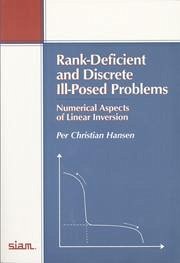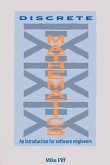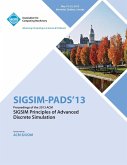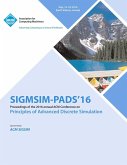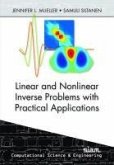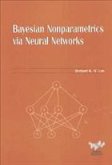Per Christian Hansen
Rank-Deficient and Discrete III-Posed Problems
Numerical Aspects of Linear Inversion
Per Christian Hansen
Rank-Deficient and Discrete III-Posed Problems
Numerical Aspects of Linear Inversion
- Broschiertes Buch
- Merkliste
- Auf die Merkliste
- Bewerten Bewerten
- Teilen
- Produkt teilen
- Produkterinnerung
- Produkterinnerung
An overview of modern computational stabilization methods for linear inversion: applications to audio processing, medical imaging, seismology and other areas.
Andere Kunden interessierten sich auch für
![Discrete Mathematics Discrete Mathematics]() Mike PiffDiscrete Mathematics71,99 €
Mike PiffDiscrete Mathematics71,99 €![Sigsim Pads 13 Proceedings of the 2013 ACM Sigsim Principles of Advanced Discrete Simulation Sigsim Pads 13 Proceedings of the 2013 ACM Sigsim Principles of Advanced Discrete Simulation]() Sigsim Pads 13 Conference CommittteeSigsim Pads 13 Proceedings of the 2013 ACM Sigsim Principles of Advanced Discrete Simulation119,99 €
Sigsim Pads 13 Conference CommittteeSigsim Pads 13 Proceedings of the 2013 ACM Sigsim Principles of Advanced Discrete Simulation119,99 €![ACM SIGSIM Conference on Principles on Advances Discrete Simulation ACM SIGSIM Conference on Principles on Advances Discrete Simulation]() Sigsim- Pads 16 Conference CommitteeACM SIGSIM Conference on Principles on Advances Discrete Simulation79,99 €
Sigsim- Pads 16 Conference CommitteeACM SIGSIM Conference on Principles on Advances Discrete Simulation79,99 €![Linear and Nonlinear Inverse Problems with Practical Applications Linear and Nonlinear Inverse Problems with Practical Applications]() Jennifer L MüllerLinear and Nonlinear Inverse Problems with Practical Applications101,99 €
Jennifer L MüllerLinear and Nonlinear Inverse Problems with Practical Applications101,99 €![A Primer on Radial Basis Functions with Applications to the Geosciences A Primer on Radial Basis Functions with Applications to the Geosciences]() Bengt FornbergA Primer on Radial Basis Functions with Applications to the Geosciences91,99 €
Bengt FornbergA Primer on Radial Basis Functions with Applications to the Geosciences91,99 €![Recipes for Continuation Recipes for Continuation]() Harry DankowiczRecipes for Continuation116,99 €
Harry DankowiczRecipes for Continuation116,99 €![Bayesian Nonparametrics Via Neural Networks Bayesian Nonparametrics Via Neural Networks]() Herbert K H LeeBayesian Nonparametrics Via Neural Networks66,99 €
Herbert K H LeeBayesian Nonparametrics Via Neural Networks66,99 €-
-
-
An overview of modern computational stabilization methods for linear inversion: applications to audio processing, medical imaging, seismology and other areas.
Hinweis: Dieser Artikel kann nur an eine deutsche Lieferadresse ausgeliefert werden.
Hinweis: Dieser Artikel kann nur an eine deutsche Lieferadresse ausgeliefert werden.
Produktdetails
- Produktdetails
- Verlag: Society for Industrial and Applied Mathematics (SIAM)
- Seitenzahl: 263
- Erscheinungstermin: 1. Januar 1987
- Englisch
- Abmessung: 255mm x 179mm x 13mm
- Gewicht: 514g
- ISBN-13: 9780898714036
- ISBN-10: 0898714036
- Artikelnr.: 23249034
- Herstellerkennzeichnung
- Libri GmbH
- Europaallee 1
- 36244 Bad Hersfeld
- gpsr@libri.de
- Verlag: Society for Industrial and Applied Mathematics (SIAM)
- Seitenzahl: 263
- Erscheinungstermin: 1. Januar 1987
- Englisch
- Abmessung: 255mm x 179mm x 13mm
- Gewicht: 514g
- ISBN-13: 9780898714036
- ISBN-10: 0898714036
- Artikelnr.: 23249034
- Herstellerkennzeichnung
- Libri GmbH
- Europaallee 1
- 36244 Bad Hersfeld
- gpsr@libri.de
Preface
Symbols and Acronyms
1. Setting the Stage. Problems With Ill-Conditioned Matrices
Ill-Posed and Inverse Problems
Prelude to Regularization
Four Test Problems
2. Decompositions and Other Tools. The SVD and its Generalizations
Rank-Revealing Decompositions
Transformation to Standard Form
Computation of the SVE
3. Methods for Rank-Deficient Problems. Numerical Rank
Truncated SVD and GSVD
Truncated Rank-Revealing Decompositions
Truncated Decompositions in Action
4. Problems with Ill-Determined Rank. Characteristics of Discrete Ill-Posed Problems
Filter Factors
Working with Seminorms
The Resolution Matrix, Bias, and Variance
The Discrete Picard Condition
L-Curve Analysis
Random Test Matrices for Regularization Methods
The Analysis Tools in Action
5. Direct Regularization Methods. Tikhonov Regularization
The Regularized General Gauss-Markov Linear Model
Truncated SVD and GSVD Again
Algorithms Based on Total Least Squares
Mollifier Methods
Other Direct Methods
Characterization of Regularization Methods
Direct Regularization Methods in Action
6. Iterative Regularization Methods. Some Practicalities
Classical Stationary Iterative Methods
Regularizing CG Iterations
Convergence Properties of Regularizing CG Iterations
The LSQR Algorithm in Finite Precision
Hybrid Methods
Iterative Regularization Methods in Action
7. Parameter-Choice Methods. Pragmatic Parameter Choice
The Discrepancy Principle
Methods Based on Error Estimation
Generalized Cross-Validation
The L-Curve Criterion
Parameter-Choice Methods in Action
Experimental Comparisons of the Methods
8. Regularization Tools
Bibliography
Index.
Symbols and Acronyms
1. Setting the Stage. Problems With Ill-Conditioned Matrices
Ill-Posed and Inverse Problems
Prelude to Regularization
Four Test Problems
2. Decompositions and Other Tools. The SVD and its Generalizations
Rank-Revealing Decompositions
Transformation to Standard Form
Computation of the SVE
3. Methods for Rank-Deficient Problems. Numerical Rank
Truncated SVD and GSVD
Truncated Rank-Revealing Decompositions
Truncated Decompositions in Action
4. Problems with Ill-Determined Rank. Characteristics of Discrete Ill-Posed Problems
Filter Factors
Working with Seminorms
The Resolution Matrix, Bias, and Variance
The Discrete Picard Condition
L-Curve Analysis
Random Test Matrices for Regularization Methods
The Analysis Tools in Action
5. Direct Regularization Methods. Tikhonov Regularization
The Regularized General Gauss-Markov Linear Model
Truncated SVD and GSVD Again
Algorithms Based on Total Least Squares
Mollifier Methods
Other Direct Methods
Characterization of Regularization Methods
Direct Regularization Methods in Action
6. Iterative Regularization Methods. Some Practicalities
Classical Stationary Iterative Methods
Regularizing CG Iterations
Convergence Properties of Regularizing CG Iterations
The LSQR Algorithm in Finite Precision
Hybrid Methods
Iterative Regularization Methods in Action
7. Parameter-Choice Methods. Pragmatic Parameter Choice
The Discrepancy Principle
Methods Based on Error Estimation
Generalized Cross-Validation
The L-Curve Criterion
Parameter-Choice Methods in Action
Experimental Comparisons of the Methods
8. Regularization Tools
Bibliography
Index.
Preface
Symbols and Acronyms
1. Setting the Stage. Problems With Ill-Conditioned Matrices
Ill-Posed and Inverse Problems
Prelude to Regularization
Four Test Problems
2. Decompositions and Other Tools. The SVD and its Generalizations
Rank-Revealing Decompositions
Transformation to Standard Form
Computation of the SVE
3. Methods for Rank-Deficient Problems. Numerical Rank
Truncated SVD and GSVD
Truncated Rank-Revealing Decompositions
Truncated Decompositions in Action
4. Problems with Ill-Determined Rank. Characteristics of Discrete Ill-Posed Problems
Filter Factors
Working with Seminorms
The Resolution Matrix, Bias, and Variance
The Discrete Picard Condition
L-Curve Analysis
Random Test Matrices for Regularization Methods
The Analysis Tools in Action
5. Direct Regularization Methods. Tikhonov Regularization
The Regularized General Gauss-Markov Linear Model
Truncated SVD and GSVD Again
Algorithms Based on Total Least Squares
Mollifier Methods
Other Direct Methods
Characterization of Regularization Methods
Direct Regularization Methods in Action
6. Iterative Regularization Methods. Some Practicalities
Classical Stationary Iterative Methods
Regularizing CG Iterations
Convergence Properties of Regularizing CG Iterations
The LSQR Algorithm in Finite Precision
Hybrid Methods
Iterative Regularization Methods in Action
7. Parameter-Choice Methods. Pragmatic Parameter Choice
The Discrepancy Principle
Methods Based on Error Estimation
Generalized Cross-Validation
The L-Curve Criterion
Parameter-Choice Methods in Action
Experimental Comparisons of the Methods
8. Regularization Tools
Bibliography
Index.
Symbols and Acronyms
1. Setting the Stage. Problems With Ill-Conditioned Matrices
Ill-Posed and Inverse Problems
Prelude to Regularization
Four Test Problems
2. Decompositions and Other Tools. The SVD and its Generalizations
Rank-Revealing Decompositions
Transformation to Standard Form
Computation of the SVE
3. Methods for Rank-Deficient Problems. Numerical Rank
Truncated SVD and GSVD
Truncated Rank-Revealing Decompositions
Truncated Decompositions in Action
4. Problems with Ill-Determined Rank. Characteristics of Discrete Ill-Posed Problems
Filter Factors
Working with Seminorms
The Resolution Matrix, Bias, and Variance
The Discrete Picard Condition
L-Curve Analysis
Random Test Matrices for Regularization Methods
The Analysis Tools in Action
5. Direct Regularization Methods. Tikhonov Regularization
The Regularized General Gauss-Markov Linear Model
Truncated SVD and GSVD Again
Algorithms Based on Total Least Squares
Mollifier Methods
Other Direct Methods
Characterization of Regularization Methods
Direct Regularization Methods in Action
6. Iterative Regularization Methods. Some Practicalities
Classical Stationary Iterative Methods
Regularizing CG Iterations
Convergence Properties of Regularizing CG Iterations
The LSQR Algorithm in Finite Precision
Hybrid Methods
Iterative Regularization Methods in Action
7. Parameter-Choice Methods. Pragmatic Parameter Choice
The Discrepancy Principle
Methods Based on Error Estimation
Generalized Cross-Validation
The L-Curve Criterion
Parameter-Choice Methods in Action
Experimental Comparisons of the Methods
8. Regularization Tools
Bibliography
Index.

